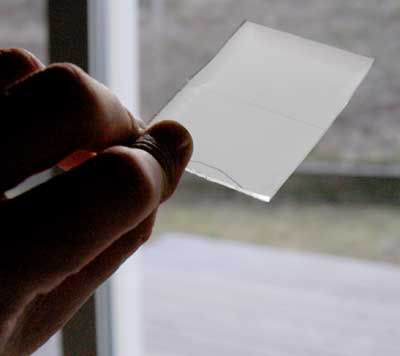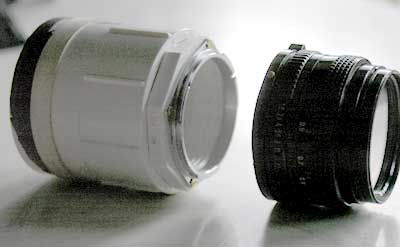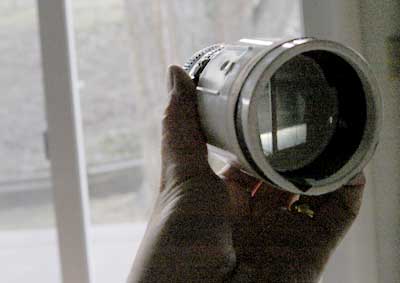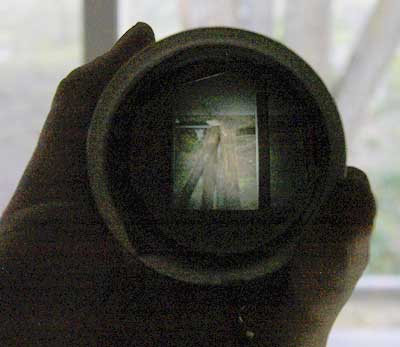Mini-35mm Adapter
These adapters enable a video camera user to place professional 35mm cinema lenses onto his or her video camera. However, there is nothing inherent about "cinema" lenses that create a cinema look. (see the side bar for more details) This is done to create the high quality images associated with professional cinema equipment. There are a few designs and types of mini-35mm adapters and they work with varying degrees of success.
The first type of adapter is what we will cal a "DIRECT" adapter. This adapter works with video cameras that have an interchangeable lens mount like the Canon XL2 or an industrial video camera like the Hitachi KP-D50. This adapter is generally a kind of ring that slips over a cinema lens's mount and fits into the cameras mount. These days most cinema lenses are PL mount. Older, and more affordable cinema lenses, came in Arri standard mount and even C-mount.
In the case of the Hitachi KP-D50 the camera mount is C mount so if cinema lenses with C mount like some Angenieux lenses and Wollensack lenses readily have then no adapter is required. However, if an Arri standard mount lens is to be used an adapter is required.
In the case of the Canon XL2 no real direct adapter can be used. You may have seen direct type of adapters made for Arri standard mount, or PL mount or other various cinema lens mounts but these adapters will always result in unsatisfactory results with the Canon XL2 or any 3-CCD camera. The reason is that cinema lenses and 3-CCD lenses focus light differently. Cameras that have 3-CCD (in the old days 3-tubes) use lenses that focus the three primary colors of light at three different back focal distances. (The back focal distance is the focal distance between the lens and the CCDs)
Cinema lenses focus the three primary colors of light to a single distance, the distance from the back of the lens to the film. If a lens that was designed for 3-CCD video use was placed on a film camera only one of the three primary colors of light could be in sharp focus at a time. The red light could be focused but the green light would be soft and the blue light would be more out of focus still. Like wise when a cinema lens is placed on a 3-CCD camera only one of the three primary colors of light can be focus at a time. This is because each of the CCDs is a 3-chip camera are at different distances from the back of the lens. This is done because of the design of the color video lens.
The second type of adapter is the "GROUND GLASS' adapter. These adapters mount a cinema lens in front of a piece of ground glass which substitutes for the cameras film and acts as a kind of projection screen. The video camera then frames the image the cinema lens projects onto the ground glass and permanently focuses on it. In this way the video cameras lens is set up one time when the adapter is placed on the video camera and the cinema lens is adjusted for focus and depth of field. This adapter can be used on any video camera and has the major advantage of recreating the highly selectable focus found in 35mm film cameras. Adapters can even be made to use 35mm still camera lenses, medium format still camera lenses, and 16mm cinema camera lenses. when 16mm lenses are used they create a smaller projected image so the video camera as to frame-up and focus on a smaller image. This makes the grain on the ground glass appear bigger. Also, because the circles of confusion will be smaller in this format the selectable focus will not be as narrow as 35mm format. The 16mm lenses will produce a more narrow selectable focus that video camera with 2/3rds inch chips and far better than cameras with smaller chips than 2/3rds inch. However, for the very best in very narrow selectable focus medium format camera lenses produce very large projected images onto the ground glass and can produce a very shallow depth of field when the f-stop is left relatively open.
 Grain can be an undesirable artifact of the ground glass adapter, partly because the can can be very large on smaller format lenses and partly because the grain is static unlike the random position of the grain structure in a film image that varies frame to frame. One solution is to produce a ground glass that moves, or spins. Spinning ground glass adapters produce higher resolution images that fixed ground glass systems but are far more complicated to construct and cost considerably more. However, the spinning ground glass cinema lens adapters will go along ways to producing more filmick look on video.
Grain can be an undesirable artifact of the ground glass adapter, partly because the can can be very large on smaller format lenses and partly because the grain is static unlike the random position of the grain structure in a film image that varies frame to frame. One solution is to produce a ground glass that moves, or spins. Spinning ground glass adapters produce higher resolution images that fixed ground glass systems but are far more complicated to construct and cost considerably more. However, the spinning ground glass cinema lens adapters will go along ways to producing more filmick look on video.
In the photos on this page you will see a canon camera mount, removed from an old non-working canon ae 35mm SLR camera, and placed on a a few pieces of PVC plumbing fixtures purchased at a local hardware store. The canon lens covers an 8perf pull were cinema lenses only  cover a 4perf area. This means that the camera lens creates an image twice the size as cinema lenses making the perceived grain of the ground glass even smaller. The ground glass was purchased from anchor optics (Edmond optics surplus seller) in a 8"X8" sheet and it was cut down to fit in the plastic piece using a regular glass cutter which can be acquired from a hardware store or craft supply store. The PVC piece would then be placed into a bracket and mounted on a lens rail in front of a video camera that could focus close enough to frame up the image on the ground glass. Here is a youtube video taken with the actual homemade adaptor shown in the photos: http://www.youtube.com/watch?v=y7eMKsNcdBE
cover a 4perf area. This means that the camera lens creates an image twice the size as cinema lenses making the perceived grain of the ground glass even smaller. The ground glass was purchased from anchor optics (Edmond optics surplus seller) in a 8"X8" sheet and it was cut down to fit in the plastic piece using a regular glass cutter which can be acquired from a hardware store or craft supply store. The PVC piece would then be placed into a bracket and mounted on a lens rail in front of a video camera that could focus close enough to frame up the image on the ground glass. Here is a youtube video taken with the actual homemade adaptor shown in the photos: http://www.youtube.com/watch?v=y7eMKsNcdBE
 The placement of the ground glass in the PVC piece is the only critical part of the assembly. The glass needs to be placed at a precise fixed distance from the back of the lens for the lens to be able to focus an image properly. Different lens manufacturers have different back focal distances. So a little homework will have to be done to discover the FFD (flange focal distance). A quick and dirty way to set the FFD is to mount the lens focus the lens to infinity and point the lens at a very distant object. Then move the ground glass into position where the distant object come into focus. Finally fix the ground glass in this position so it can not move.
The placement of the ground glass in the PVC piece is the only critical part of the assembly. The glass needs to be placed at a precise fixed distance from the back of the lens for the lens to be able to focus an image properly. Different lens manufacturers have different back focal distances. So a little homework will have to be done to discover the FFD (flange focal distance). A quick and dirty way to set the FFD is to mount the lens focus the lens to infinity and point the lens at a very distant object. Then move the ground glass into position where the distant object come into focus. Finally fix the ground glass in this position so it can not move.
WHO IS THE MINI-35mm ADAPTER FOR?
 If you have a video camera and you want to gain more control over your selectable focus this type of adapter is for you. If you want to create a softer look, or a desaturated look, or a look with ground glass grain structure then you will doubtlessly want to get one of these adapters. If you want your video camera to "look" like a serious piece of film equipment this adapter will convince most everyone you have really professional tools.
If you have a video camera and you want to gain more control over your selectable focus this type of adapter is for you. If you want to create a softer look, or a desaturated look, or a look with ground glass grain structure then you will doubtlessly want to get one of these adapters. If you want your video camera to "look" like a serious piece of film equipment this adapter will convince most everyone you have really professional tools.
If you want your image to look like film, put your video camera away and invest in, or rent a film camera. If you don't know how to shoot film start with a SLR still camera. This is a very affordable way to start to learn how to shoot film. You can easily take a class from a community college, but film classes are starting to disappear because of the widespread perception that digital is better than film, and because most people want to shoot only on modern equipment. Few people seem to be are aware that the vast majority of motion picture images, and all of the highest quality motion picture images are shot on film. There is no debate about this. There are a few block buster type films that have been shot mostly or partially in video but they are few and far between and often do not compare well against the old fashioned film process. Video cameras have made amazing jumps in their ability to produce higher and higher quality images. Closer and closer to the old standard of film. But what many video makers fail to realize is that there have been large advances in film technology. Modern films stocks (of the 21st Century) are simply amazing in their dynamic range and resolving power. They out perform old film stocks several times. So a 40 year old film camera can be loaded with film stock that is more modern than the XL-2 or Varicam and produce images that are many times better in resolution, shadow detail, highlight detail and color reproduction. The mini-35mm adapters do not make your video images comparable to film. They may make the operators feel like they are operating a film camera but they would be under a delusion at best. One day video cameras will perform as well as film cameras. Someday they will even out perform them, because so much resource is directed at their development, but that day has yet to come despite the fact that the perception is already in place.
SIDE BAR
35mm cinema lenses do have a larger coverage area, that is they produce an image on the film plane, or on the ground glass that is about 24mm x 24mm, and they are achromats and in some cases apochromats (provideo lenses are neither) and they are marked with T-stops (transmission stops) in addition to f-stops. But there is not difference between a cinema camera lens and a still camera lens other than the area they cover. In fact, still camera lenses cover almost 36mm x 36mm. Medium format lenses can cover an even larger area. What does this mean? It means that if these lenses were used in a ground glass video adaptor the circle of confusion would be larger and selectable focus would be increased. And because the ground glass is larger the video camera would not have to be as close to the ground glass and a wider range of camera could be used with an adaptor that employed still camera lenses. Further, because the ground glass is larger the size of the grain will appear smaller and more like a real film grain instead of the large glass grain that can be distracting on many ground glass adaptors. Finally, very high quality still camera lenses are readily available and far more affordable than cinema lenses. Often, good still camera lenses like Nikons and Canons are far superior to available cinema lenses. |
|
If you have question or comments about this webpage please feel free to email Nathan Snyder from the contact page.

 Grain can be an undesirable artifact of the ground glass adapter, partly because the can can be very large on smaller format lenses and partly because the grain is static unlike the random position of the grain structure in a film image that varies frame to frame. One solution is to produce a ground glass that moves, or spins. Spinning ground glass adapters produce higher resolution images that fixed ground glass systems but are far more complicated to construct and cost considerably more. However, the spinning ground glass cinema lens adapters will go along ways to producing more filmick look on video.
Grain can be an undesirable artifact of the ground glass adapter, partly because the can can be very large on smaller format lenses and partly because the grain is static unlike the random position of the grain structure in a film image that varies frame to frame. One solution is to produce a ground glass that moves, or spins. Spinning ground glass adapters produce higher resolution images that fixed ground glass systems but are far more complicated to construct and cost considerably more. However, the spinning ground glass cinema lens adapters will go along ways to producing more filmick look on video.  cover a 4perf area. This means that the camera lens creates an image twice the size as cinema lenses making the perceived grain of the ground glass even smaller. The ground glass was purchased from anchor optics (Edmond optics surplus seller) in a 8"X8" sheet and it was cut down to fit in the plastic piece using a regular glass cutter which can be acquired from a hardware store or craft supply store. The PVC piece would then be placed into a bracket and mounted on a lens rail in front of a video camera that could focus close enough to frame up the image on the ground glass. Here is a youtube video taken with the actual homemade adaptor shown in the photos:
cover a 4perf area. This means that the camera lens creates an image twice the size as cinema lenses making the perceived grain of the ground glass even smaller. The ground glass was purchased from anchor optics (Edmond optics surplus seller) in a 8"X8" sheet and it was cut down to fit in the plastic piece using a regular glass cutter which can be acquired from a hardware store or craft supply store. The PVC piece would then be placed into a bracket and mounted on a lens rail in front of a video camera that could focus close enough to frame up the image on the ground glass. Here is a youtube video taken with the actual homemade adaptor shown in the photos:  The placement of the ground glass in the PVC piece is the only critical part of the assembly. The glass needs to be placed at a precise fixed distance from the back of the lens for the lens to be able to focus an image properly. Different lens manufacturers have different back focal distances. So a little homework will have to be done to discover the FFD (flange focal distance). A quick and dirty way to set the FFD is to mount the lens focus the lens to infinity and point the lens at a very distant object. Then move the ground glass into position where the distant object come into focus. Finally fix the ground glass in this position so it can not move.
The placement of the ground glass in the PVC piece is the only critical part of the assembly. The glass needs to be placed at a precise fixed distance from the back of the lens for the lens to be able to focus an image properly. Different lens manufacturers have different back focal distances. So a little homework will have to be done to discover the FFD (flange focal distance). A quick and dirty way to set the FFD is to mount the lens focus the lens to infinity and point the lens at a very distant object. Then move the ground glass into position where the distant object come into focus. Finally fix the ground glass in this position so it can not move. If you have a video camera and you want to gain more control over your selectable focus this type of adapter is for you. If you want to create a softer look, or a desaturated look, or a look with ground glass grain structure then you will doubtlessly want to get one of these adapters. If you want your video camera to "look" like a serious piece of film equipment this adapter will convince most everyone you have really professional tools.
If you have a video camera and you want to gain more control over your selectable focus this type of adapter is for you. If you want to create a softer look, or a desaturated look, or a look with ground glass grain structure then you will doubtlessly want to get one of these adapters. If you want your video camera to "look" like a serious piece of film equipment this adapter will convince most everyone you have really professional tools.